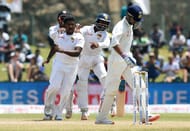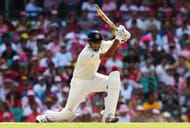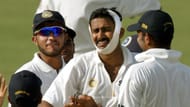It’s easy for armchair critics (such as yours truly) to pour so much vitriol on the new-look Team India as it reels from yet another defeat in Test matches. To borrow a phrase from the irascible Geoffrey Boycott, the way these guys played was absolute rubbish.
Dealing with the aftermath of a loss that could have been the win they were so desperately seeking, skipper Virat Kohli and current coach Ravi Shastri have expounded ad nauseum on the need for aggressive cricket. But it has backfired spectacularly on them in more than one way, and remedial measures must be taken to rectify what has been a constant thorn in their flesh since 2011.
For starters, this posturing of aggression must go. What these boys have done is that they have forgotten to stick to basics in their quest for ‘fearless’ cricket. They are a unit, not a disparate bunch of individuals, and they have to realize that quickly or more heartache will be in store. It’s not about how aggressive you are on the field – it’s a lot more than that.
Perhaps a fresh take on what the way forward could be, and the immediate need that is to be addressed, will go a long way in helping India to come out of the funk that they’re in currently:
Gauging: Size Up the Situation & Respond, not React, to it
He may not have been the best player in the longest form of the game, but Mahendra Singh Dhoni does read the nuances of cricket quite well. His philosophy is simple – get in, focus on the job at hand, decide the approach accordingly, and proceed to play. It is exactly the sort of mantra our dear management professors loved to drum into our not-so-focused minds about four years ago.
But while the limited-overs captain has had a fair bit of experience under his belt, his successor is yet finding his feet in those big shoes. Nevertheless, the motto of Test cricket remains the same.
You have to take stock of the situation on hand when you walk out to the middle. The current crop of youthful cricketers, nurtured on a staple diet of lightning-fast Twenty20, didn’t do that on that fateful Saturday in Galle. The result is right in front of us.
Another impression that I received from the way the Indians approached the entire fourth innings chase was that they were more reactive, instead of being responsive. Test matches are a stern examination of your patience, your strength (both mental and physical) and your commitment to deliver victory to your side.
Hence, you’ve got to be able to respond to things, not react and lash out in frustration just because the opposition seems to have worked you out. By responding to high-pressure situations with your skills and abilities, you’re effectively laying the foundation for the rest of the batsmen to follow, or, when bowling, plugging away at the rival lineup with your bag of tricks in hopes of inducing a false stroke sometime. That is one sore spot which Kohli & Shastri have to address soon.
Guts & Patience: Soaking the Pressure & Toughing it out
It’s one thing to play according to the situation of the match. But what happens when the opposition is constantly coming hard at you? Suddenly you find yourselves in two minds: attack or defend?
Your scoring areas are plugged up, you’ve spent nearly three hours without a run added to the scoreboard, and you’re getting frustrated. Sound eerily familiar? This young Indian squad is facing just that kind of stark reality, and succumbing to it.
The purpose of Test cricket is exactly what it is named for – toughing it out in the middle despite seemingly overwhelming odds. It’s about being extremely patient and keeping things moving. I wouldn’t be in favour of hitting your way out of deep trouble; while it has proven to be effective at times, it should never be your primary aim in the five-day version.
Depending on pitch conditions & the quality of the opposition, chasing smaller targets with two full days in hand should ideally be simple. However, this works only if you have the guts to hang in for long periods, soaking in all the pressure, and pushing the score along.
The likes of Rahul Dravid and VVS Laxman achieved phenomenal success in their distinguished careers in white flannels mostly because they had immense levels of patience to fight pressure with everything they had in them. Steve Waugh’s stubborn resistance in his final Test match also stands out in everyone’s memory.
While it is necessary to give this fledgling young side of Kohli’s ample time to re-assess and re-calibrate their game, it is also important to remember that time may be running out for a few of them. Nevertheless, having guts and patience is a form of aggressive cricket – simple and far more effective than smashing everything in sight – a brand of the game that India will do well to relearn.
Gumption: The Willingness to Fight the Odds
The sight of a bandaged Anil Kumble bowling against the West Indies in Antigua more than a decade ago is perhaps the finest example of gumption seen in the 21st century. In severe pain and desperately in need of a rest, the average chap would prefer to spend time at the clinic for treatment.
The former India leg-spinner, however, was cut from a different cloth. He played through the injury, even getting a prized wicket, before finally giving in to his body’s demands. That’s what gumption is all about – you will yourself to fight despite the odds being heavily stacked against you.
However, the young turks have yet to learn this art. With the rule changes for on-field treatment, it’s no wonder that old-timers consider them to be a pampered lot. And it’s beginning to affect their game in the long version – how many of the current squad would have the courage to give up a lucrative IPL contract in order to toil away in the dust bowls of domestic cricket? They want things to come easy, and when they don’t, these boys are affected so much so that they start questioning their game and play recklessly.
Test matches have this unique ability to cut a cricketer down to size. Quite simply, if you have the stomach for a long battle, become a master of survival and manage to steer your side to safety or victory, then you belong in the highest echelons of cricket.
You just don’t give in to anything, chipping away despite knowing your team is in line for another defeat. Why? Because you’ve got the will to soldier on, eyeing triumph in the face of adversity. Fourth innings chases are tricky, more so if it’s a small target (by Test standards); however, there are no excuses if you’ve managed to buy plenty of time to reach the goal and ruin it all by surrendering meekly to the opposition.
In the end, what you will be known for is how far you were willing to go to pull your team from the depths of despair. The Blue Brigade can take heart from their ODI run in 2008 to 2012 during chases – they didn’t give up then, so why not do the same in Test matches?
Going for Broke & Finishing: Taking Charge of Proceedings and Ending the Game
This is the stage that the Indians must live up to, what with all their talk about playing aggressive, fearless cricket. While tenacity, guts and patience will go a long way in laying a solid foundation, picking up the pace by playing some powerful shots is not an altogether bad option either. Be it any format of the game, an all-out attack is quite effective especially when the base is sound. That’s what Dinesh Chandimal did at Galle.
You have to ensure you don’t overdo the rampaging bit. For example, if you hit a bowler for consecutive boundaries, it’s quite unnecessary to repeat the same shots immediately afterwards. The rival camp isn’t stupid or inexperienced, so underestimating them while you’re in attack mode is a fatal error. There is plenty of time for you to get settled and then send the opposite side on a leather hunt.
Finishing games is extremely vital in ODI & T20 cricket, but doing so in the Test arena is actually ten times more satisfying. It’s a true testament to you as a team, as cricket professionals, and as sportsmen. A draw in a keenly contested game is an honourable result, a narrow victory even more so (as Andrew Flintoff & Brett Lee experienced in the 2005 Ashes, and India realized in 2010 against South Africa).
In summary, the Indian team needs to just fine-tune its basics and rework their mental makeup in order to come back in the ongoing series. These young firebrands hate to lose, and perhaps the Galle defeat might be a sign that they’re ready to turn it around. Playing smart cricket (again, it is a much more subtle version of aggressive) is the need of the hour.
Brand-new app in a brand-new avatar! Download CricRocket for fast cricket scores, rocket flicks, super notifications and much more! 🚀☄️




